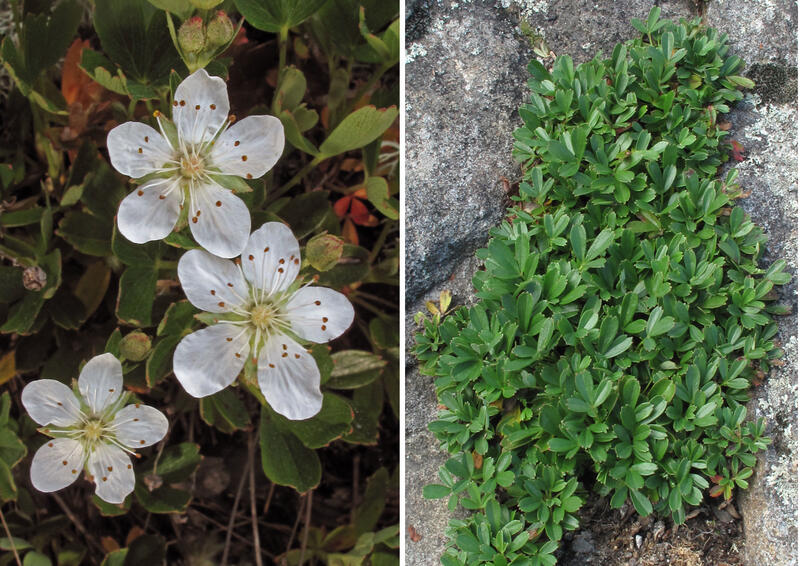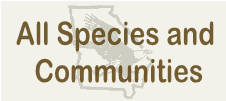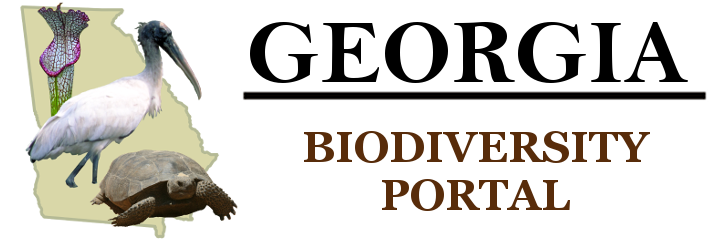







Loading profile. Please wait . . .
Sibbaldiopsis tridentata (Ait.) Rydb.
Three-toothed Cinquefoil




Federal Protection: No US federal protection
State Protection: Endangered
Global Rank: G5
State Rank: S1
Element Locations Tracked in Biotics: Yes
SWAP 2015 Species of Greatest Conservation Need (SGCN): Yes
SWAP 2025 Species of Greatest Conservation Need (SGCN): Yes
2025 SGCN Priority Tier: Moderate Conservation Concern
Element Occurrences (EOs) in Georgia: 3
Habitat Summary for element in Georgia: Rocky summits
Perennial herb (or sub-shrub) with slightly woody stems, forming low clumps and mats, usually 3 - 4 inches (7 - 10 cm) tall (rarely up to 12 inches), with a creeping rootstock. The leaves have 3 oblong leaflets, 0.6 - 1 inch (1.5 - 2.5 cm) long, with 3 - 5 teeth at the tip; the base of the leaf stalk has a toothed sheath (stipule); the leaves turn maroon and overwinter. The flowers are about 0.8 inch (2 cm) wide, with 5 white petals, 5 green, showy sepals, and 25 - 30 showy, white stamens. Fruits are dry and hairy, in a stalked cluster.
The native Wild Strawberry (Fragaria virginiana) and Mock Strawberry (Duchesnea indica) from Asia have hairy stems, juicy red fruits, and deciduous, oval leaflets with many-toothed margins. Common cinquefoil (Potentilla simplex and P. canadensis) have yellow flowers and 5 leaflets.
None in Georgia. Sibbaldiopsis tridentata, also known as Sibbaldia retusa, is the only member of either of those genera in North America, with 4 - 6 other species occurring in Eurasia.
High-elevation rock outcrops and mountaintop balds.
Three-toothed Cinquefoil is a diminutive shrub that forms clonal clumps and mats by the spread of stolons. It has low seed production and germination and reproduces primarily by the spread of stolons. Although it often occurs with disturbance-related species, it should not be considered a part of the early successional flora. Its flowers are probably pollinated by small bees and Syrphid flies.
Surveys are best conducted during flowering (June–August); however, the leaves are distinctive all year, turning maroon in the winter.
Georgia, Tennessee, North Carolina, north to Canada, west to Iowa and North Dakota. It is common in Canada and New England, rare further south and west.
Clearing and development of high-elevation summits and rocky ridges. Trampling by hikers and climbers. Introduction of invasive species' seeds on hikers' boots. Construction of cell phone towers on summits. Sibbaldiopsis tridentata is common in northern states and is found only in high elevation sites in the South, indicating that it is temperature-sensitive. Increased temperatures related to climate change threaten the persistence of this species in the South.
| Threat 1 | Threat 2 | Threat 3 | |
|---|---|---|---|
| General Threat | Human intrusions & disturbance | Climate change & severe weather | Natural system modifications |
| Specific Threat | None | None | None |
Sibbaldiopsis tridentata is ranked S1 by the Georgia Department of Natural Resources, indicating that the species is critically imperiled in Georgia. It is listed as Endangered by the State of Georgia. Two populations are known in Georgia, both in heavily visited areas of the Chattahoochee National Forest, where they are vulnerable to disturbance.
Georgia’s plants are the southernmost populations of this species. Plants occurring at the periphery of a species’ range are thought to be of special conservation importance. Peripheral populations are usually smaller and less genetically diverse within the population, but genetically divergent from centrally located populations. These genetic differences may confer special survival traits that plants in other portions of the species’ range lack, such as the ability to survive changes in the climate or the arrival of a new pathogen. Peripheral populations may be in the process of evolving into a new species. They are especially deserving of conservation action.
Avoid clearing, developing, and cell tower construction on high elevation summits, ridges, and rock outcrops. Direct trails away from populations of these plants. Install boot scrapers on trails entering high-elevation mountaintops to remove invasive species' seeds. Monitor sites for invasion by exotic grasses. Address climate change and monitor populations for temperature stress.
Bresowar, G.E. and G.L. Walker. 2011. Patterns of genetic distribution of Sibbaldiopsis tridentata (Rosaceae) in the Eastern United States. Castanea 76(2): 210-221. https://bioone.org/journals/Castanea/volume-76/issue-2/10-039.1/Patterns-of-Genetic-Distribution-of-Sibbaldiopsis-tridentata-Rosaceae-in-the/10.2179/10-039.1.short
Chafin, L.G. 2007. Field guide to the rare plants of Georgia. State Botanical Garden of Georgia and University of Georgia Press, Athens.
Eriksson, T., M. Lundberg, M. Töpel, P. Őstensson, and J.E.E. Smedmark. 2015. Sibbaldia: a molecular phylogenetic study of a remarkably polyphyletic genus in Rosaceae. Plant Systematics and Evolution 301: 171-184. https://link.springer.com/article/10.1007/s00606-014-1063-3
Eriksson, T., M.J. Donoghue, and M.S. Hibbs. 1998. Phylogenetic analysis of Potentilla using DNA sequences of nuclear ribosomal internal transcribed spacers (ITS), and implications for the classification of Rosoideae (Rosaceae). Plant Systematics and Evolution 211: 155-179. https://link.springer.com/article/10.1007/BF00985357
Ertter, B. and J.L. Reveal. 2015. Sibbaldiopsis tridentata species account. Flora of North America, vol. 9. http://beta.floranorthamerica.org/Sibbaldiopsis_tridentata
GADNR. 2020. Element occurrence records for Sibbaldiopsis tridentata. Georgia Department of Natural Resources, Wildlife Resources Division, Social Circle, Georgia.
Hilty, J., 2012. Three-toothed Cinquefoil, Sibbaldiopsis tridentata species account. Illinois wildflowers. http://www.illinoiswildflowers.info/prairie/plantx/tth_cinquefoil.htm
Marchand, P. and D.A. Roach. 1980. Reproductive strategies of pioneering alpine species: seed production, dispersal, and germination. Arctic and Alpine Research 12(2): 137-146. https://www.tandfonline.com/doi/abs/10.1080/00040851.1980.12004173
NatureServe. 2020. Sibbaldiopsis tridentata species account. NatureServe Explorer. NatureServe, Arlington, Virginia. https://explorer.natureserve.org/Taxon/ELEMENT_GLOBAL.2.129815/Sibbaldiopsis_tridentata
Patrick, T.S., J.R. Allison, and G.A. Krakow. 1995. Protected plants of Georgia. Georgia Department of Natural Resources, Natural Heritage Program, Social Circle.
Juraj, P. and J. Soják. 2009. Taxonomic comments on the genus Sibbaldiopsis Rydb.
(Rosaceae). Journal of the National Museum (Prague), Natural History Series 178(4):15-16. https://www.researchgate.net/profile/Juraj_Paule/publication/282324588_Taxonomic_comments_on_the_genus_Sibbaldiopsis_Rydb_Rosaceae/links/56e81c0008aea51e7f3b176f/Taxonomic-comments-on-the-genus-Sibbaldiopsis-Rydb-Rosaceae.pdf
Radford, A.E., H.E. Ahles, and C.R. Bell. 1968. Manual of the vascular flora of the Carolinas. University of North Carolina Press, Chapel Hill.
Smreciu, A., S. Wood, and K. Gould. 2013. Species account for three-toothed cinquefoil, shrubby five fingers. https://era.library.ualberta.ca/items/8b63737a-7f6f-4d06-a0d5-35d03b114580/view/6e3e01e5-dceb-48a5-af48-5e5164b32f0e/Sibbaldiopsis-20tridentata.pdf
Weakley, A.S. 2015. Flora of the southern and mid-Atlantic States. University of North Carolina Herbarium, University of North Carolina, Chapel Hill. http://www.herbarium.unc.edu/flora.htm
Linda G. Chafin
L. Chafin, Aug. 2008: original account.
K. Owers, Feb. 2010: added pictures.
L. Chafin, May 2020: updated original account.